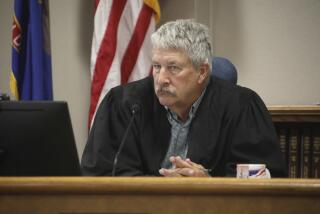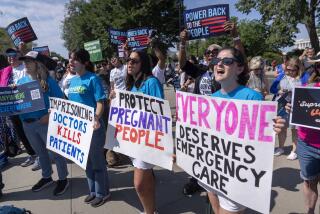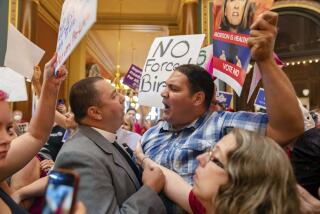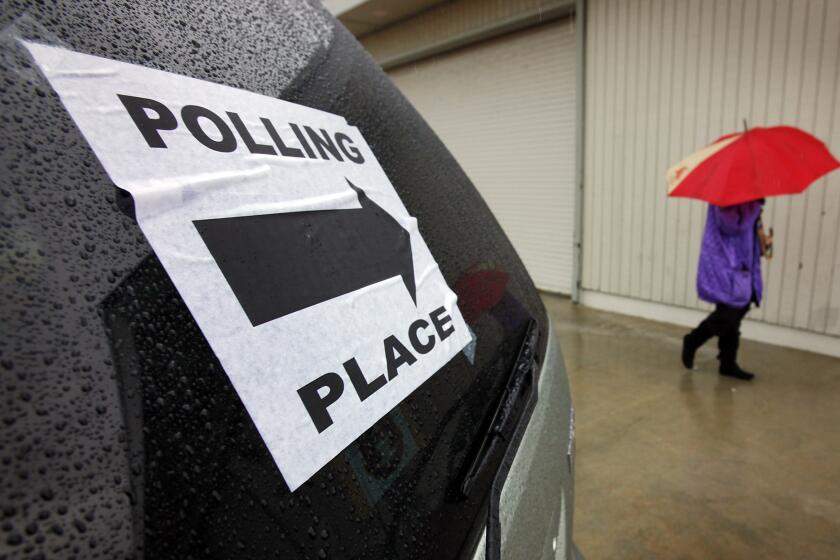High court backs ban on disputed abortion method
WASHINGTON — The Supreme Court changed course on abortion Wednesday, upholding a national ban on a midterm method of ending pregnancies. The decision clears the way for states to pass new laws designed to discourage women from having abortions.
In a 5-4 ruling applauded by antiabortion forces, the court said the “government has a legitimate and substantial interest in preserving and promoting fetal life.” In 2000, the court, also by a 5-4 margin, struck down a nearly identical state law on the grounds that it could force some women to undergo riskier surgery during the fourth or fifth month of pregnancy. But the retirement of Justice Sandra Day O’Connor in 2005 and President Bush’s appointment of Samuel A. Alito Jr. to succeed her tipped the balance the other way.
It was the first time the court upheld a ban on an abortion procedure. Though Wednesday’s opinion does not overturn Roe vs. Wade, the 1973 decision establishing a constitutional right to abortion, the majority said it was prepared to uphold new restrictions on doctors who perform them and women who seek them.
Justice Anthony M. Kennedy, speaking for the court, said that the government may not forbid abortion outright but that it “may use its voice and its regulatory authority” to dissuade women from ending pregnancies. The ban on what opponents call “partial-birth” abortions will “encourage some women to carry the infant to full term, thus reducing the absolute number” of such abortions, he added.
Chief Justice John G. Roberts Jr. and Justices Antonin Scalia, Clarence Thomas and Alito joined Kennedy’s opinion. In a separate statement, Thomas and Scalia said they would vote to overrule Roe vs. Wade entirely.
The decision is likely to elevate the abortion issue in the 2008 presidential campaigns. Two of the court’s strongest supporters of the right to abortion are also its oldest: John Paul Stevens will be 87 on Friday, and Ruth Bader Ginsburg is 74. The next president might have to nominate one or more new justices.
Ginsburg, the court’s only woman, called Wednesday’s decision “alarming.”
It “cannot be understood as anything other than an effort to chip away at a right declared again and again by this court,” she said.
She said this dispute was about how, not whether, abortions would be performed during the second trimester. Despite Kennedy’s talk of “promoting fetal life,” the ban on the procedure “targets only a method of abortion,” she said. “The woman may abort the fetus, so long as her doctor uses another method, one her doctor judges less safe for her.”
She also called the decision demeaning to women. It “pretends” to protect them “by denying them any choice in the matter,” she said.
Stevens and Justices David H. Souter and Stephen G. Breyer joined her dissent.
The ruling culminates a 12-year campaign by the National Right to Life Committee to outlaw the procedure, which its leaders were the first to dub “partial-birth” abortion. They said the procedure was akin to “infanticide” because the fetus is killed after being extracted partly from the uterus.
Bush praised the decision as a step toward “protecting human dignity and upholding the sanctity of human life.” Congress enacted the ban and he signed it into law four years ago, but it was struck down as unconstitutional by three lower courts.
Abortion rights advocates voiced outrage over Wednesday’s decision. It “is a stunning assault on women’s health and the expertise of doctors who care for them,” said Nancy Northup of the Center for Reproductive Rights. “This court believes that members of Congress -- not doctors -- are in the best position to make medical decisions for their patients.”
In one sense, the ruling may have more symbolic than practical significance. By most estimates, the disputed procedure is used in fewer than 5,000 of the more than 1.3 million abortions performed nationwide each year.
However, the legal battle turned on the question of whether a woman and her doctor, or elected lawmakers, should decide on abortion.
Most abortions -- 85% to 90% -- are done in the first three months of pregnancy. In those cases, the fetus is removed through a suction tube.
Later in pregnancy, however, some form of surgery is required. Most doctors give the woman anesthesia and use instruments to remove the fetus in pieces. This procedure is known as dilation and evacuation, or D&E;, and remains legal.
Some doctors who perform second-term abortions said it was safer to remove the fetus intact because that method is less likely to expose the woman to injury, bleeding or infection. Usually, doctors collapse the fetus’ skull, or drain its content, to permit its removal. This method is known as dilation and extraction, or D&X.;
Congress criminalized D&X; in the Partial Birth Abortion Ban Act of 2003. The law permits doctors to use the procedure if it is necessary to save the woman’s life. However, there is no exception for instances where doctors say it is needed to preserve her health.
In 2000, Dr. LeRoy Carhart of Bellevue, Neb., successfully challenged Nebraska’s law. He also sued to strike down the federal ban, but was on the losing end in Wednesday’s ruling in Gonzales vs. Carhart.
The Supreme Court’s opinion sets out two major changes to abortion law.
Since Roe vs. Wade in 1973, justices have examined abortion measures before they go into effect and have struck down those that might threaten the life or health of some women in the future. These pre-enforcement challenges are referred to as “facial challenges.”
Now, the court said it would allow such abortion laws to go into effect first when they do not raise a broad constitutional concern. Challengers still may bring an “as applied” suit, Kennedy said. For example, if doctors can show D&X; is needed for women who have a particular medical condition, they could seek a court order that exempts them from the law, he said.
Second, the court in the past said it would strike down abortion laws that might threaten the health of some patients. Kennedy’s opinion acknowledged that some nationally recognized medical experts testified that the ban on D&X; could “create significant health risks” for some women who undergo midterm abortions.
But that alone is not enough to void the law, Kennedy concluded. There are other safe methods of performing these abortions, he said, and doctors are not entitled to “unfettered choice in the course of their medical practice.”
The ruling highlights Kennedy’s central role on the court, particularly on the issue of abortion. In 1992, he cast a decisive fifth vote to preserve the right to abortion.
Though he is personally opposed to abortion, he has said he was not willing to overturn a long-standing constitutional right. But he has said the government could strictly regulate abortion and seek to dissuade women from ending their pregnancies. He reiterated both points in Wednesday’s opinion.
He also left no doubt that he found the disputed procedure abhorrent. Announcing his opinion in the court, he said some women regret their decision to have an abortion. A woman would suffer “grief more anguished and sorrow more profound when she learns, only after the event, that she allowed a doctor to pierce the skull and vacuum the fast-developing brain of her unborn child,” he said.
For Roberts and Alito, the ruling was their first major decision on abortion, and it made clear both would support stricter regulation. However, it remains unclear whether they would vote to overturn Roe vs. Wade if given a chance.
That chance could come in a few years if Stevens or Ginsburg was replaced by a staunchly conservative justice.
Advocates on both sides of the abortion debate said the ruling underscored the importance of elections.
Conservatives said support for Bush and his Supreme Court nominees had paid off. “At last, a modest decision based on principles of judicial restraint: allowing ‘we the people’ to make laws supported by a clear majority of Americans without interference from unelected judges,” said Wendy Long, counsel for the Judicial Confirmation Network, which rallied support for Roberts and Alito.
Nancy Keenan, president of NARAL Pro-Choice America, agreed that “elections matter.”
“An anti-choice Congress and anti-choice president pushed this ban all the way to the Supreme Court.”
*
*
Begin text of infobox
Pending cases
Some abortion cases yet to be decided by federal courts:
‘Partial-birth’ abortion
Multiple states: Abortion rights advocates say the high court ruling is likely to influence lawsuits in Missouri, Virginia and Utah that challenge state laws banning what critics call “partial-birth” abortion.
Michigan: There is an effort to overturn a state law that defines a human embryo or fetus as a “legally born person” once any non-severed part of the embryo or fetus emerges through a vagina. Opponents say by that definition, physicians performing any abortion, even in early pregnancy, are at risk of committing murder under Michigan law.
* In a 2005 ruling, U.S. District Judge Denise Page Hood in Detroit said the law, known as the Legal Birth Definition Act, places an “undue burden” on a woman’s right to choose. The case is in the U.S. 6th Circuit Court of Appeals.
Informed consent
South Dakota: A lawsuit is challenging a measure that requires doctors to tell women seeking abortions that the procedure ends a human life.
* Both sides say if the law is upheld it will probably be duplicated across the nation. The case is in the U.S. 8th Circuit Court of Appeals.
Abortion pills
Ohio: There is a lawsuit challenging a law making it illegal for doctors to prescribe mifepristone, known as RU-486, after the seventh week of pregnancy. Under federal guidelines, the drug cannot be prescribed after 56 days of pregnancy.
* U.S. District Judge Susan Dlott in the 6th Circuit ruled in September that the Ohio law was unconstitutional, saying doctors couldn’t be expected to understand its requirements.
* The appeals court had previously stopped short of rejecting the entire law but said it could be deemed unconstitutional unless lawmakers added an exemption for cases in which women would be at greater risk through surgical abortions.
Prison abortions
Missouri: A lawsuit is challenging a federal ruling that allows prisoners to get abortions.
* In 2005, the Supreme Court ruled the state had to allow a specific inmate, listed as Jane Roe, to have an abortion. That came after prison officials abandoned a long-standing policy of providing transportation and guards for inmates wanting abortions. .
* The American Civil Liberties Union is now suing to give all female prisoners in Missouri that right to abortion.
*
Sources: Associated Press, Americans United for Life, Planned Parenthood
**
The decision
Excerpts from the Supreme Court’s 5-4 ruling upholding the Partial Birth Abortion Ban Act of 2003.
The majority
Respondents have not demonstrated that the act, as a facial matter, is void for vagueness, or that it imposes an undue burden on a woman’s right to abortion based on its overbreadth or lack of a health exemption.
* There is documented medical disagreement whether the act’s prohibition would ever impose significant health risks on women.... The question becomes whether the act can stand when this medical uncertainty persists. The court’s precedents instruct that the act can survive this facial attack.
* In a decision so fraught with emotional consequence, some doctors may prefer not to disclose precise details of the means that will be used, confining themselves to the required statement of risks the procedure entails.... Any number of patients facing imminent surgical procedures would prefer not to hear all details, lest the usual anxiety preceding invasive medical procedures become the more intense. This is likely the case with the abortion procedures here in issue.... It is, however, precisely this lack of information concerning the way in which the fetus will be killed that is of legitimate concern to the state.
* It is self-evident that a mother who comes to regret her choice to abort must struggle with grief more anguished and sorrow more profound when she learns, only after the event, what she once did not know: that she allowed a doctor to pierce the skull and vacuum the fast-developing brain of her unborn child, a child assuming the human form.
* It is a reasonable inference that a necessary effect of the regulation and the knowledge it conveys will be to encourage some women to carry the infant to full term, thus reducing the absolute number of late-term abortions. The medical profession, furthermore, may find different and less shocking methods to abort the fetus in the second trimester, thereby accommodating legislative demand.
* Physicians are not entitled to ignore regulations that direct them to use reasonable alternative procedures. The law need not give abortion doctors unfettered choice in the course of their medical practice, nor should it elevate their status above other physicians in the medical community.
In dissent
Today’s decision is alarming.... It tolerates, indeed applauds, federal intervention to ban nationwide a procedure found necessary and proper in certain cases by the American College of Obstetricians and Gynecologists.
* Retreating from prior rulings that abortion restrictions cannot be imposed absent an exception safeguarding a woman’s health, the court upholds an act that surely would not survive under the close scrutiny that previous attended state-decreed limitations on a woman’s reproductive services.
* For the first time since Roe, the court blesses a prohibition with no exception safeguarding a woman’s health.
*
Source: Associated Press
More to Read
Get the L.A. Times Politics newsletter
Deeply reported insights into legislation, politics and policy from Sacramento, Washington and beyond. In your inbox three times per week.
You may occasionally receive promotional content from the Los Angeles Times.











